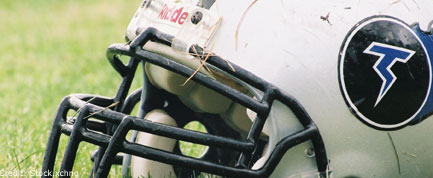Bad Sports Behavior Starts in Youth

From the "athletes behaving badly" department (in the past two weeks, anyway):
- NHL bad boy (Sean Avery) was suspended for six games for a crude remark.
- Six NFL players were suspended for violating the league's drug policy.
- Another NFL player (Adam "Pacman" Jones) returned to his team's roster after being suspended, again, for an off-field altercation.
- Oh, and NFL receiver (Plaxico Burress) accidentally shot himself in a nightclub with a gun he was not licensed to carry.
Despite the 24/7 media coverage of each of these incidents, sports fans have become accustomed to and somewhat complacent with hearing about athletes and their deviant acts.
In fact, new statistics reveal that bad behavior is clearly evident among high school athletes, particularly in high-contact sports.
It starts young Besides the highly publicized stories, there are thousands more across the nation involving amateur athletes taking risks both on and off the field. From performance-enhancing supplements to referee/official abuse to fights, guns and recorded crimes, the image of sports as a positive influence on athletes may need a second look. Granted, in a population of any size there will be a few bad apples. However, these actions have become so prevalent that academic researchers have created a branch of study called "deviance in sports" attached to the sports sociology tree.
They are asking questions and challenging some assumptions about cause and effect. Is there a connection between sports participation and deviance? Does the intense competition and battle on the field shape a player's off-the-field lifestyle? Since success in sports brings attention and prestige to athletes, does the risk of losing that status cause a need to take risks to maintain their "top dog" positions? In their new book, "Deviance and Social Control in Sport," researchers Michael Atkinson and Kevin Young emphasize the confusing environment surrounding athletes. They describe two types of deviance: wanted and unwanted. Owners, players and fans may know that certain behaviors are literally against the rules but are at the same time appreciated as a sign of doing whatever it takes to win. Performance-enhancing drugs are not allowed in most sports, but athletes assume they will improve their performance, which helps their team win and keeps fans happy. Fights in hockey will be, according to the rule book, penalized, but this deviance is assumed to be wanted by fans and teammates as a sign of loyalty.
However, related bad behavior can quickly turn on a player to being socially unwanted.
Abuse of drugs that don't contribute to a win, (marijuana, cocaine, alcohol), will transform that same player into a villain with shock and outrage being reported in the media. In the Sean Avery example, a hockey player fighting to defend his teammates on the ice can then be suspended from the team and criticized by those same teammates for an off-color remark.
Get the world’s most fascinating discoveries delivered straight to your inbox.
Real statistics Most athletes who make it to the professional level have been involved in sports since youth. Sports sociologists and psychologists often look at the early development years of athletes to get a glimpse of patterns, social norms and influences that contribute to later behaviors. In a recent American Sociological Review article, Derek Kreager, assistant professor of sociology at Penn State University, challenged the long-held belief that youth sports participation is exclusively beneficial to their moral character development.
With the focus on teaching teamwork, fair play, and self esteem, sports are often cited as the antidote to delinquency. But Kreager notes that other studies have looked at the culture that surrounds high school and college athletes and identified patterns of clichés, privileges and attitudes of superiority. For some athletes, these patterns are used to justify deviant behavior. In fact, his most recent research attempted to find a cause-and-effect link between deviant behavior and specific sports. Specifically, he asked if high-contact, physical sports like football and wrestling created athletes who were more prone to violent behavior off the field. Using data from the National Longitudinal Study of Adolescent Health, more than 6,000 male students from across 120 schools were included. The data set included a wide collection of socioeconomic information, including school activities, risk behaviors and at-home influences. Kreager's study analyzed the effects of three team sports (football, basketball, and baseball) and two individual sports (wrestling and tennis) on the likelihood of violent off-field behavior, specifically, fighting.
To isolate the effect of each sport, the study included control groups of non-athletes and those that had a history of physical violence prior to playing sports.
For team sports, football players were 40 percent more likely to be in a confrontation than non-athletes. In individual sports, wrestlers were in fights 45 percent more often, while tennis players were 35 percent less likely to be in an altercation. Basketball and baseball players showed no significant bias either way. "Sports such as football, basketball, and baseball provide players with a certain status in society," Kreager said. "But football and wrestling are associated with violent behavior because both sports involve some physical domination of the opponent, which is rewarded by the fans, coaches and other players. Players are encouraged to be violent outside the sport because they are rewarded for being violent inside it."
- Wide-Faced Men More Aggressive
- Cheating in Sports: Oh, The Inequity
- Humans Crave Violence Just Like Sex
Dan Peterson blogs about sports science at his site Sports Are 80 Percent Mental and at Scientific Blogging.


